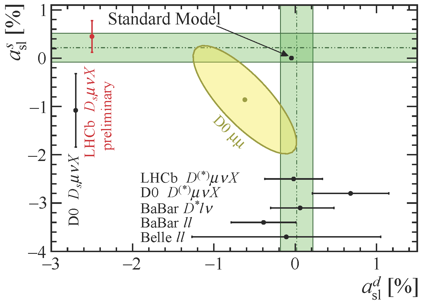[ assl = (0.39±0.26±0.20)% ]
Last week at the 16th International Conference on B-Physics at Frontier Machines, “Beauty 2016”, Marseille, France, the LHCb collaboration presented the updated result of a measurement of the semileptonic asymmetry, assl, related to a difference between a probability of a beauty meson, B0s, to oscillate into its antimatter partner, B0s, and a probability of the reverse process. (An introduction to beauty and charm oscillations can be found in the 7 November 2012 news item.) Any difference in this probability would be a manifestation of CP-violation, which is the difference between the properties of matter and anti-matter. The label “s” indicates decays of B0s mesons composed of anti-beauty b and s quarks, while “sl” (semileptonic) indicates that leptons, in this case muons, are present among decay products. The full run 1 data sample of 3 fb-1 was used to obtain this update of the 1 fb-1 2012 measurement. The LHCb result is the most precise measurement of assl to date and is consistent with the value predicted in the framework of the Standard Model. For this particular quantity the amount of CP-violation is expected to be tiny and hence the predicted value of assl in the Standard Model is very small. Therefore the possible contribution of as yet undiscovered effects, which help to drive the B0s – B0s oscillations, could lead to significant changes in assl. The precise LHCb result allows constraints to be placed on the properties of these possible new effects, and points the way for future theoretical and experimental studies.
The image shows the overview of the most precise measurements of assl and adsl. The adsl results were obtained from analogous measurements of B0-B0 oscillations. The new LHCb result is shown, as well as the LHCb adsl 2014 result. The horizontal and vertical bands indicate the naive averages of pure assl and adsl measurements obtained by different experiments. These averages are consistent with the small values predicted by the Standard Model and show no evidence for new physics effects.
The yellow ellipse shows a result from a measurement of the D0 experiment at the Tevatron which is related but not uniquely determined by a linear combination of assl and adsl. This result could indicate the presence of a new physics contribution, see the 7 July 2012 news for details. However, this measurement is not in good agreement with the results for the individual measurements of assl and adsl.
Read more in the LHCb presentation at Beauty 2016, in the LHCb paper and in the CERN Courier article

